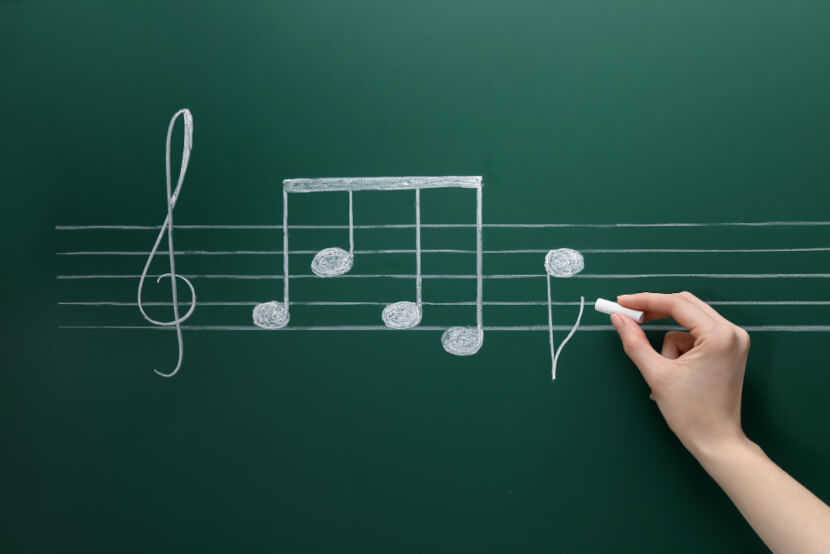This article is tailored for musicians who wish to delve into the world of music transcription, offering insights and tools to enhance this skill. Let’s embark on this harmonious journey of understanding and applying music theory to transcription.
Understanding the Basics of Music Theory
Notes and Pitch
In music transcription, a clear understanding of notes and pitch is crucial. Notes are the alphabet of music, each with a distinct pitch and frequency. Recognizing these pitches and their notational values is the first step in transcription. Consider the A4 440 Hz standard pitch: it serves as a tuning reference. But pitches can vary, especially in non-Western music. Transcribers must be adept at identifying these nuances. Moreover, understanding scales, which are sequences of notes in a specific order, helps in predicting melodic trends, essential for accurate transcription.
Rhythm and Tempo
Rhythm is the framework of music, marked by the sequence of sounds and silences in time. Mastering different time signatures, such as 4/4 or 3/4, is essential for transcribers. Tempo, the speed of a piece, further defines its rhythm. It can vary from slow (largo) to fast (presto). Transcribers often struggle with complex rhythms like syncopation or irregular time signatures. Mastery in rhythm transcription requires not just theoretical knowledge but also rhythmic intuition, developed through consistent practice and exposure to varied musical styles.
Key Signatures and Scales
Key signatures are a map to understanding a piece’s tonality. They indicate the key of the piece and help in identifying which notes are to be played sharp or flat throughout. For transcribers, this means recognizing the key at the start to accurately transcribe the music. Scales form the basis of melodies and harmonies. Major and minor scales are most common, but there are also modal, chromatic, and pentatonic scales. Knowledge of these scales aids in anticipating the direction of a melody, making transcription more intuitive and accurate.
Advanced Music Theory Concepts
Harmony and Chords
Harmony, created through chords, adds depth to music. Chords are groups of notes played simultaneously. Understanding chord progressions, the sequence of chords played in a piece, is crucial for transcribers. This knowledge helps in identifying underlying harmonies and transcribing them correctly. Major, minor, diminished, and augmented chords each have a unique sound and function within a progression. Recognizing these chords and their inversions, and understanding how they contribute to the overall harmony, is key to accurate transcription.
Melody and Counterpoint
Melodies are the most recognizable aspect of a piece. They are sequences of notes that are perceived as a single entity. Transcribing melodies involves a keen ear for pitch and rhythm. Counterpoint, the art of combining multiple independent melodies, presents a unique challenge. Each melody, or voice, must be transcribed while maintaining its relationship with the others. This requires an understanding of how different melodic lines interact and overlap. Recognizing patterns and common practices in counterpoint can greatly aid in this complex aspect of transcription.
Dynamics and Articulation
Articulation and dynamics are crucial in conveying the mood and character of a piece. Dynamics refer to the volume of music, ranging from very soft (pianissimo) to very loud (fortissimo). Articulation affects how a note is played, such as staccato (short and detached) or legato (smooth and connected). Accurately transcribing these elements requires a sensitive ear and an understanding of standard notational practices. This subtlety in transcription ensures that the performance instructions to the musician are clear, preserving the composer’s intent.
Practical Tips for Transcribers
Ear Training
Ear training is fundamental for transcribers. It involves developing the ability to identify and understand musical elements by ear. This includes recognizing intervals (the distance between two pitches), chord qualities, and rhythmic patterns. Regular ear training exercises can significantly improve transcription accuracy. Transcribers should practice identifying these elements in different contexts and styles of music, as it enhances their ability to transcribe accurately and efficiently.
Notation Software and Tools
Notation software is an invaluable tool for modern transcribers. Programs like Finale, Sibelius, and MuseScore offer features that simplify the transcription process. These tools allow for easy input of notes, rhythms, and other musical symbols. They also provide playback features, enabling transcribers to hear their work and make adjustments as needed. Familiarizing oneself with these tools and their functionalities can greatly streamline the transcription process, making it more efficient and accurate.
Common Transcription Challenges
Transcription is not without its challenges. Complex rhythms, particularly in genres like jazz or contemporary classical music, can be difficult to capture accurately. Polyphonic textures, where multiple melodies are played simultaneously, require a keen ear and a thorough understanding of counterpoint. Transcribers should approach these challenges patiently, breaking down the music into smaller, more manageable segments, and using slow playback tools when necessary. Practice and experience are key in overcoming these challenges.
Applying Music Theory in Transcription
Case Studies
Examining real-world examples of transcription where music theory is applied can be highly educational. These case studies often reveal how theoretical concepts are put into practice. Analyzing transcriptions across different genres can provide insights into how melody, harmony, rhythm, and other elements are interpreted and notated. Such analyses can also highlight genre-specific challenges and solutions, enriching the transcriber’s skill set.
Genre-Specific Considerations
Different musical genres have distinct transcription considerations. For instance, jazz often involves complex chords and improvisation, requiring a deep understanding of jazz harmony and rhythm. Classical music, on the other hand, may feature more structured compositions and a greater emphasis on dynamics and articulation. Being aware of these genre-specific nuances is crucial for accurate and stylistically appropriate transcriptions. This knowledge enables transcribers to capture the essence of the music, regardless of the genre.
Conclusion
Transcription is a vital skill that marries auditory perception with musical notation. It demands a deep understanding of music theory and a keen ear. Continuous learning and practice in these areas will not only enhance the accuracy of your transcriptions but also enrich your overall musical experience. Remember, effective transcription is not just about writing down notes—it’s about capturing the spirit and intent of the music.

